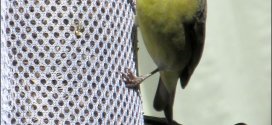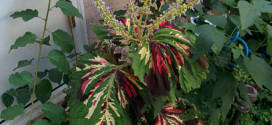You can’t get any easier to grow than Linaria purpurea. Slender spikes of tiny violet-blue snapdragon-like flowers over narrow, whorled, blue-grey leaves light up many an old garden. Blooms all Summer in full sun or part shade. Fairly drought tolerant once established & it reseeds! To 3’ high & 1’ wide, it looks good in groupings. Native to southeastern Europe.
Read More »admin
Lily – Fortnight
Attractive, light yellow iris-like flowers with vivid maroon blotches loom on stiff stalks over neat clumps. Fire resistant. Fortnight lily are evergreen perennials with spreading fans of stiff, leathery sword shaped leaves up to 2 ft in length but only 0.75 in wide. Be aggressive in your pruning of them. The upright clumps of leaves are held in a vertical …
Read More »Blue Thimble Flower
The Gilia genus contains mostly desert-loving plants, native to the area stretching from the western United States to South America. Spanish botanists Hipólito Ruiz and José Antonio Pavón found the first known Gilia species on their expedition to South America, later detailing it among other species in a 1794 publication of their research from Peru and Chile. They gave this …
Read More »Angelonia
Native to Mexico and the West Indies, angelonia (sometimes also called summer snapdragon) is an upright, glabrous, somewhat bushy, tropical perennial that is noted for its long summer bloom of small snapdragon-like flowers. Plants typically grow 12-18” tall. Stems are clad with narrow, oblong to lanceolate, green leaves (to 3” long) with toothed margins. Foliage is slightly aromatic. Bluish-purple flowers …
Read More »Pepino Dulce
Pepino Dulce produces fruit that are the size of a large goose egg with a cream-colored rind that usually has beautiful purple stripes. I will give you time to look up the size of a goose egg. It has a sweet, mild flesh that is somewhat melon-like. Used fresh in salads or cooked. Beautiful, glossy ornamental plants require a very long …
Read More »Lesser Goldfinch
Colorful and energetic, the lesser goldfinch is a welcome bird in the southwestern United States and Mexico. Not only does this finch have a delightful trilling song, but its propensity to eat thousands of weed seeds is appreciated by farmers and gardeners alike. Common Name: Lesser Goldfinch Scientific Name: Carduelis psaltria Appearance: Bill: Conical, pointed, dark Size: 4.5 inches long …
Read More »Dianthus
The name Dianthus is from the Greek words dios (“god”) and anthos (“flower”), and was cited by the Greek botanist Theophrastus. The color pink may be named after the flower, coming from the frilled edge of the flowers: the verb “pink” dates from the 14th century and means “to decorate with a perforated or punched pattern”. Ecology: Dianthus species are …
Read More »Coleus
Coleus is a pretty foliage plant , Solenostemon scutellarioides Family: Lamiaceae (lay-mee-AY-see-ee) (Info) Genus: Solenostemon (sol-en-oh-STEM-on) (Info) Species: scutellarioides (skew-tell-ar-ee-OH-ih-deez) (Info) Synonym:Coleus blumei Synonym:Coleus scutellarioides Category: Annuals Tropicals and Tender Perennials Height: 12-18 in. (30-45 cm) 18-24 in. (45-60 cm) Spacing: 9-12 in. (22-30 cm) Hardiness: USDA Zone 9a: to -6.6 °C (20 °F) …
Read More »Verbena
Rose Verbena, Purple Verbena, Homestead Verbena, Glandularia canadensis Family: Verbenaceae (ver-be-NAY-see-ee) (Info) Genus: Glandularia (glan-doo-LAIR-ee-uh) (Info) Species: canadensis (ka-na-DEN-sis) (Info) Cultivar: ? Synonym:Glandularia drummondii Synonym:Glandularia lambertii Synonym:Verbena canadensis Synonym:Verbena lambertii Synonym:Verbena x ? Category: Perennials Height: 6-12 in. (15-30 cm) Spacing: 6-9 in. (15-22 cm) 18-24 in. (45-60 cm) 24-36 in. (60-90 cm) 36-48 in. (90-120 cm) …
Read More »Chile – Anaheim
Anaheim Pepper. Named for the California city where they first became popular in the early 1900s, Anaheim chiles are one of the most commonly available peppers in the United States. Anaheims are large, 6- to 10-inch-long cone-shaped pods that come in green and red varieties (red ones are also called chile colorado). Red Anaheim chiles are often dried for later use …
Read More »








